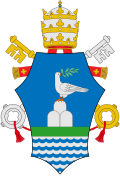| Fulgens radiatur Latin for 'The Radiant Light' Encyclical of Pope Pius XII | |
|---|---|
 | |
| Signature date | 21 March 1947 |
| Number | 11 of the pontificate |
Fulgens radiatur (English: 'The Radiant Light') issued March 21, 1947 is an encyclical of Pope Pius XII on Saint Benedict. It was written in the context of the heavy destruction of the Benedictine Monte Cassino monastery during the Battle of Monte Cassino in World War II. [1] [2]
